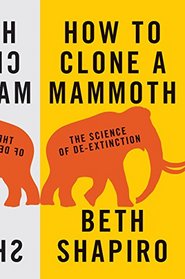Search -
How to Clone a Mammoth: The Science of De-Extinction
How to Clone a Mammoth The Science of De-Extinction
Author:
Could extinct species, like mammoths and passenger pigeons, be brought back to life? The science says yes. In How to Clone a Mammoth, Beth Shapiro, evolutionary biologist and pioneer in "ancient DNA" research, walks readers through the astonishing and controversial process of de-extinction. From deciding which species should be restored, to sequ... more »
Author:
Could extinct species, like mammoths and passenger pigeons, be brought back to life? The science says yes. In How to Clone a Mammoth, Beth Shapiro, evolutionary biologist and pioneer in "ancient DNA" research, walks readers through the astonishing and controversial process of de-extinction. From deciding which species should be restored, to sequ... more »
ISBN-13: 9780691173115
ISBN-10: 0691173117
Publication Date: 8/30/2016
Pages: 240
Edition: Reprint
Rating: 1
ISBN-10: 0691173117
Publication Date: 8/30/2016
Pages: 240
Edition: Reprint
Rating: 1
3.5 stars, based on 1 rating
Publisher: Princeton University Press
Book Type: Paperback
Other Versions: Hardcover
Reviews: Amazon | Write a Review
Book Type: Paperback
Other Versions: Hardcover
Reviews: Amazon | Write a Review
Genres:
- Reference
- Science & Math >> Biological Sciences >> Animals >> Dinosaurs
- Science & Math >> Biological Sciences >> Biotechnology
- Science & Math >> Biological Sciences >> Zoology
- Science & Math >> Evolution >> Genetics
- Science & Math >> Evolution >> Organic
- Outdoors & Nature >> Conservation >> Endangered Species





